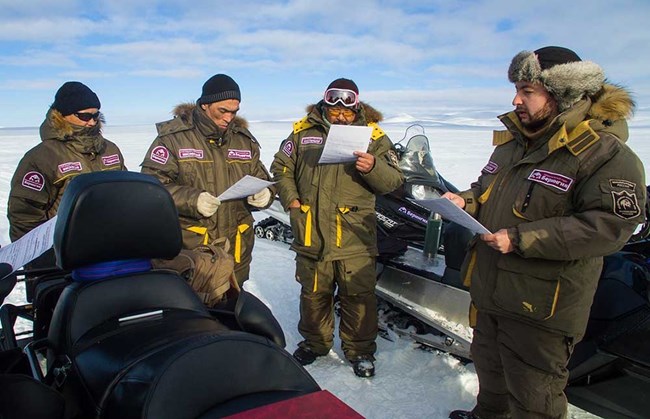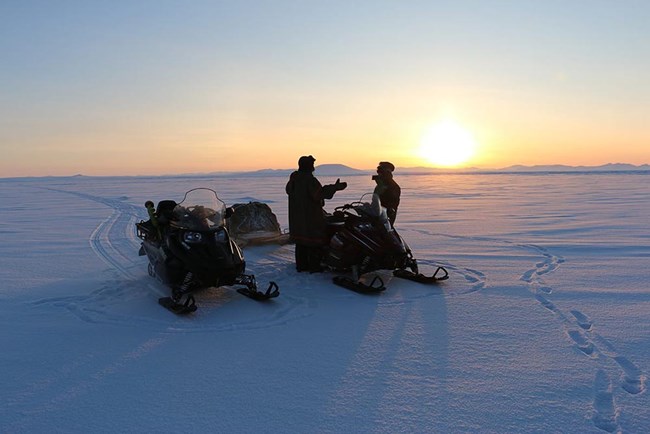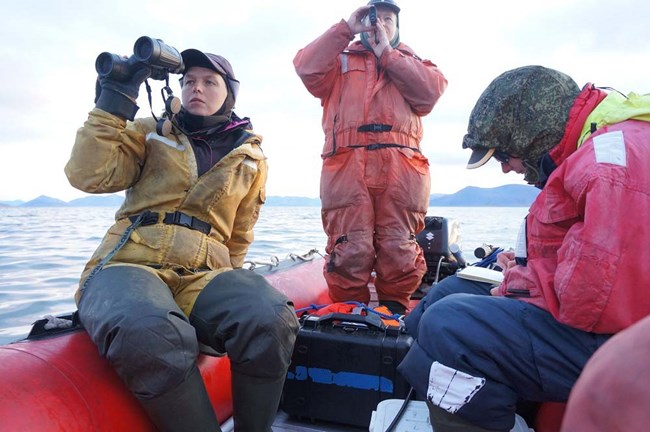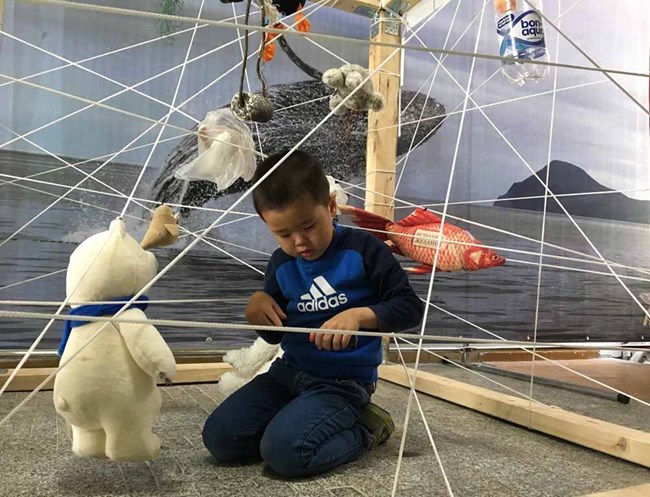Part of a series of articles titled Alaska Park Science - Volume 20, Issue 2. Beringia: A Shared Heritage.
Previous: The Fur Seals of Early American Alaska
Article

Photo Courtesy of Olga Titova
Among all the territories of unquestionable global significance, Beringia occupies the main place… This is the most important crossroad of migration routes of land and sea organisms, which contributes to the study of Earth’s evolution.
– N. M. Zabelina, 1987, National Parks
Beringia National Park is the easternmost protected area in Russia. It is located at the meeting point of two continents, Eurasia and North America, and two oceans, the Pacific Ocean and the Arctic Ocean. The park consists of five separate clusters: Kolyuchinsky, Chegitunsky, Dezhnevsky, Mechigmensky, and Providensky, located in the three municipalities of Chukotka. The national park is significant because of its surprisingly rich Arctic biodiversity and wide variety of landscapes (Materialy 2011). It features boundless tundra, high mountain ranges intercepted by fjords, unique sites of ancient maritime hunters, and the vibrant living culture of Chukotka Indigenous peoples (Bogoslovskaya 2009).
Beringia National Park was established on January 17, 2013, but its history goes back several decades earlier. Beginning in the 1960s, different specialists and representatives of environmental agencies of the Soviet Union and the United States of America started discussing the idea of a specially protected territory in the Bering Strait region for the preservation of the rich natural and cultural heritage of ancient Beringia, which is both globally significant and crucial for Indigenous people on both sides of the strait (Brawn 1990). In 1990, the Presidents of the Soviet Union (Russia) and the United States signed two different memoranda confirming the countries’ interest in creating an International Park. The joint statement of the two presidents declared that:
by creating this park, the United States of America and the Soviet Union assume responsibility over the preservation of the region of a planetary significance (Bush and Gorbachev 1990).
The proposed Soviet-U.S. park was to include both land and maritime protected territories on both sides of the Bering Strait and foster collaboration between the people of both countries: scientists, nature protection specialists, tourists, and especially Indigenous people. However, this vision of trans-boundary protected territory was not realized in part because of land management issues.
One of the key roles in the creation of Beringia National Park belonged to Lyudmila Bogoslovskaya. For many years, Bogoslovskaya worked in Chukotka as a biologist, ecologist, and ethnographer, promoting integrated natural and cultural preservation in the Bering Strait region. In 1991, she took the lead in developing the plan for the proposed park in Chukotka.
According to Bogoslovskaya’s vision, this specially protected territory should have included coastal zones of the Chukchi and Bering seas because of their importance for natural and cultural heritage. The entire planned park territory was to remain accessible for traditional subsistence activities. Planning was conducted in collaboration with the Indigenous population, who over many centuries accumulated deep knowledge and understanding of their environment and learned how to care for its resources (Tekhnio-ekonomicheskoe obosnovanie 1991).
In 1993, the Russian Government designated a part of the Chukotka Peninsula as a specially protected natural territory of regional importance, a Beringia ethno-natural park. In anticipation of its “international” fate, the regional park began developing expertise in protecting and researching its vast territory.
In the early 2000s, the Russian Government changed the park’s status to federal protected area, renaming it Beringia National Park, as intended in the original project. At the same time, its concept underwent significant changes. Most notably, the park’s territory did not include coastal and marine zones. The park was established on January 17, 2013. The creation of the national park was not the end, but rather the beginning of a long road to preserve this unique territory.
In 2015, the administration of the park began working on the National Park Regulations, a fundamental document regulating the federally protected natural area, its special protection regimes, and functional zoning. Work on the regulations lasted two years. Several meetings were held with the villagers and the administrations of the three municipalities bordering the park, where functional zoning was discussed, and the views and wishes of the local population were taken into consideration.
Currently, work is underway to create a marine protection zone as part of the national park, adjacent to the land areas. The creation of this zone will protect marine and coastal ecosystems from industrial fishing, coal extraction and exploration, and marine traffic-related pollution, but will not affect the traditional subsistence and Indigenous lifestyle.

Photo courtesy of Maxim Antipin

Photo courtesy of Olga Titova
Beringia National Park is on the homeland of the Indigenous Yupik and Chukchi peoples (Bogoslovskaya et al. 2007). Their traditional way of life and strategies for environmental management shaped and preserved the valuable natural and cultural landscapes. Preserving the unique natural and cultural heritage of Chukotka is the main purpose of the national park and cannot be achieved without the people who live there. Since its inception, the national park maintained an active dialogue with local residents. One mechanism for developing mutually beneficial cooperation between the park and the local communities is the Community Council, which creates avenues for the local populations’ direct participation in making important decisions about environmental management and conservation. Since 2016, the Beringia National Park Community Council has provided recommendations to ensure optimal solutions for the issues related to the park’s development, its integration into the socio-economic structure of the region, and the protection of its natural ecosystems.
Marine mammal hunting has several millennia of history in this region and continues today (Gusev 2009). Traditional Indigenous subsistence activities are permitted in the recreational and economic zones of the national park. Additionally, the park established a zone of traditional subsistence designed specifically to support the livelihood of the Indigenous peoples of the Russian Federation via traditional economic activities and sustainable use of renewable natural resources.
The park collaborates with local residents in the development of educational tourism. Authentic local arts and crafts are one of the park’s most important offerings to the tourists. Introduction to the contemporary culture of Indigenous peoples of Chukotka is an important and valued element of the Beringia National Park tourism program. The preservation of traditional, environmentally benign subsistence knowledge and ecological tourism development are strategies recognized world-wide for sustainable development and biodiversity conservation.
In 2020 and 2021, within the framework of the program of the Indigenous population’s adaptation to climate change, the World Wildlife Fund (WWF) Russia, in partnership with the Beringia National Park, supported about 50 local residents’ projects aimed at developing ecological tourism, preserving the traditions and nature of the region. All projects were implemented in communities bordering the Beringia National Park and most of them involved close cooperation with a specially protected natural area.
As a result of projects implemented in 2020, local communities acquired new cultural venues, workshops, guest houses, recreation areas, and private farms. In 2021, the program supported projects focused on developing dogsledding, creating of a documentary series about traditional skills, providing equipment for ivory and carpentry workshops, and educating others about local Indigenous cultures.
In 2020, Beringia National Park implemented the project “Ancestral Places” to preserve traditional knowledge about the ancient settlements of the Chukchi coast. Park staff interviewed former residents of the now-abandoned settlements of Unazik, Ukigyarak, and Kivak and others collected photographs of these places. Based on the collected data, the staff created and installed interpretive panels about these ancient settlements to share this historic heritage of Beringia with both residents of Chukotka and visitors to the protected area (Beringia 2020-2021).

Photo courtesy of Olga Kudrina

Photo courtesy of Olga Kudrina

Photo courtesy of Maxim Antipin
A national park is a fragile world that requires protection and study. It would not have been possible to preserve it for future generations without people who devoted themselves to preserving natural and cultural heritage. The staff of the Beringia National Park is small (only 43 people), but they are entrusted with a huge area—about 6,950 square miles (more than 1.8 million ha). The national park has both permanent staff and specialists who visit for a short time, for example, to conduct research and field work.
Most of the permanent staff live in the village of Providenie, where the park’s office is located. The rest reside in small villages along the coast of Chukotka, from the southernmost (Sireniki) to the northernmost (Neshkan), close to all five sections of the national park. These are district inspectors. All of them are locals, most are representatives of Indigenous peoples who know and understand the nature of Chukotka more than anyone else. Their duties are to patrol and improve the infrastructure, conduct observations, collect primary scientific data, and guide visitors.

Photo courtesy of Olga Kudrina
The work days of the employees of the national park office in Providenie are very similar to the workdays of the “mainland” (as locals call the rest of Russia) residents, if one does not consider that there is snow for 8 months of the year, that getting to work sometimes requires travelling through a snowstorm with 67 mile-per-hour (30-meters per second) winds, that spring does not come until June and winter starts in October, and that the sun does not set in summer and rises above the horizon only for 2-3 hours in winter. There is still no high-speed Internet and, in general, the cell communication often does not work in the villages and is totally absent outside them. All the necessary supplies, including food, equipment, fuel, office supplies, and clothing are delivered only by sea during the short period of northern navigation. Parts of the national park are not connected by roads and it is only possible to travel by land to all of them in early spring, on ice roads. Many park employees have never met in person and know each other only by photos.
Some of the employees come to Chukotka for a short time to test themselves in the Arctic and learn something new, others work in Beringia for many years, since the park acquired regional protected status, and cannot imagine their life without this extreme place. Some came here because of a dream, others were brought to the park by a chain of random events, some were born here and lived in this place all their life. The main thing that all have in common is the love for the nature of this amazing land and the dedication to the preservation of nature.

Photo courtesy of Maxim Antipin
The main programs of the national park are the preservation of natural resources, environmental monitoring, scientific research, environmental education, and development of educational tourism.
Preservation of unique natural resources is the priority goal and the main task of the national park, which is entrusted to the park’s department of protection. Federal inspectors have a wide array of responsibilities, including the protection of the territory, ensuring compliance with park’s regulations, preventing violations and poaching, raising public awareness, conducting environmental monitoring, guiding scientists and tour groups, and installing boundary signage.
Beringia National Park is a unique outdoor laboratory. The park’s scientists study the natural environment to develop a scientific foundation for the preservation of biodiversity, unique natural systems, and populations of rare animal and plant species. The Beringia National Park research department monitors ecosystem conditions, assesses the populations of specific animal and plant species, and makes recommendations for maintaining their sustainability. This is achieved through collecting field data on the ecology of marine mammals and seabirds, including population size, age structure, migration patterns, seasonal distribution and behavior, and describing mortality factors in the Bering Strait, Chukchi Sea, and East Siberian Sea, and effects of climate change. This information is processed through GIS mapping of the field data, including sighting of rare animal species, and geographic distribution and density of key plant and animal species. The park staff maintains and analyzes the inventory of long-term observations and data collected in the Beringia National Park and adjacent areas, compiling, and updating lists of plant and animal species, and refining their distribution maps.
Currently the national park is especially focused on inventorying its flora and fauna. Much of the park’s data on species present in the park, quantity and distribution of flora and fauna are outdated. Focused inventories were not conducted for over a decade and some species have never been inventoried. This is why the park staff priority for the next five years is to conduct inventory of flora and fauna of the protected territory. This work will be conducted both by the park staff and specially invited specialists and research organizations.
Starting in 2017, a group of botanists from the same Institute of Biological Problems and from the Institute of Biology of Inland Waters named after I.D. Papanin of the Russian Academy of Science has been working on updating the list of vascular water plants of the Beringia. They study flora of thermal springs, lakes, and lagoons. Their research points out that the distribution of most of the forms of vascular water plants began from Beringia and extended both west towards the European Russia and western Europe, and east toward North America. In Beringian refugia scientists found initial genetic types—proto forms of plants (Bobrov et al. 2021).

Photo courtesy of Tatiana Pridorozhnaya
Whale researchers from Moscow State University also began working in the park in 2017. Their work resulted in two photographic catalogues of humpback whales and gray whales of Senyavin Strait. Over the last two years, support from the World Wildlife Fund-Russia enabled specialists to study gray whale response to marine traffic noise. Such studies are particularly important in context of increased Northeast Passage and Arctic navigation (Filatova and Fedutin 2020).
In 2021, park staff conducted survey of wolves, polar and brown bears, and bighorn sheep. Contracted specialists from the Institute of Biological Problems of the North of the Far East branch of the Russian Academy of Science conducted a bird inventory in Providensky cluster of the national park. For the first time in the history of monitoring in Chukotka, the researchers used distant observation units to study birds of prey (rough-legged buzzard).

Photo courtesy of Vlada Valchenko
The environmental education department furthers the park’s conservation function by fostering the ideas of nature conservation among the public. Employees of the department organize exhibitions, environmental programs and activities, hold field-themed workshops in educational institutions, organize events for the adults in nearby communities, and develop curriculum for teachers (Zagrebin 2017, Antipina 2016; Определители). In 2021, the park initiated a special educational program, “Experience Beringia,” for the Uelen public school.
The territory of the Beringia National Park is zoned for different levels of public use. A recreational zone was established for the development of educational tourism. Park staff educates visitors about sensitive interaction with nature and wildlife, so that the knowledge and appreciation of the natural and cultural heritage contributes to its preservation. When accompanied by park specialists, the public can also visit a specially protected area. Most of the specially protected area and protected area are untouched, pristine lands.
Most visitors to the national park are, not surprisingly, residents of Chukotka. Cruise ship tourists visiting the Russian Far East are the second-largest group of visitors. These are mostly foreign visitors from more than 20 countries. Cruise ships bring about 1,000 visitors to the national park annually. The numbers of the park’s visitors from central Russia are small, usually less than 100 people, but increasing every year.

Photo courtesy of Maxim Antipin
Divided by an international border, Chukotka and Alaska share geological and environmental history as well as shared Indigenous cultures. Joint monitoring of environmental conditions and rare animal and plant species, as well as preservation of the Indigenous cultures are promising directions for collaboration between Chukotka and Alaska.
Prior to the creation of the national park, from 1993 to 2013, the regional natural park in Eastern Chukotka participated in international research projects with Alaska partners. For example, Sea Ice as a Cultural and Natural “Scape” focused on marine mammal hunters’ interaction and spiritual ties with Arctic ice and icescapes, which constitute an integral part of Arctic Indigenous peoples’ cultural heritage (Bogoslovskaya and Krupnik 2013).
Every year from 2003-2011, park staff and representatives of local Indigenous communities met at the international conference, Beringia Days, alternating locations on the Russian and Unites States sides of the Bering Strait. After 2013, contacts between the protected areas of two countries became sporadic, but 2021 marked a new period of collaboration. In spring 2021, the first time since the creation of the Beringia National Park, the National Park Service Shared Beringian Heritage Program and the Open World Leadership Center hosted a webinar to connect staff from Beringia National Park and Bering Land Bridge National Preserve that resulted in reinitiated plans for future partnerships.
Antipina, M. 2016.
Opredelitel’ Ptits Natsional’nogo Parka “Beringia” Natsional’nyi Park “Beringia.”
Beringia. 2020-2021.
Beringia: Quarterly publication of the National Park “Beringia.”
Bobrov A. A., O. A. Mochalova, and E. V. Chemiris. 2021.
Vodnye sosudistye Rasteniya Natsionalnogo Parka “Beriniga.” Botanicheskii Zhurnal 16(1): 81-99.
Bogoslovskaya, L., I. Slugin, I. Zafrebin, and I. Krupnik. 2007.
Osnovy Morskogo Zveroboinogo Promysla. Nauchno-Metodicheskoe Posobie. Russian Heritage Institute, Moscow.
Bogoslovskaya, L. S. 2009.
Zveroboee rossiiskoi Beringii, Chukotka v Proshlom i Nastouaschem. Nasledie Narodov Rossiiskoi Federatsii. Nauchno-informatsionnyi izdatel’skii tsentr, Moscow, 148-156.
Bogoslovskaya, L. and I. Krupnik. 2013.
Nashi Ldy, Snega i Vetry. Narodnye i Nauchnye Znaniya o ledovyh Landshaftakh i Klimate Vostochnoi Chukotki. Russian Heritage Institute, Moscow and Washington.
Brawn, B. 1990.
Sokhranenie naslediya Beringii. Natsional’nye Parki: Opyt SSR i SSHA, I.G. Ivanov, and A.V. Rybaov (eds.). VNIITAG, Moscow.
Bush, G. H. W. and M. S. Gorbachev. 1990.
Joint Statement of the establishment of a Soviet-United States international park in the Region of the Bering Strait, June 1, 1990. Foreign Policy Bulletin 1(1): 8-9.
Filatova, O. A. and I. D. Fedutin. 2020.
Behavioral reactions of gray whales to playback of ship noise, in Abstracts of the XI International Conference Marine mammals of the Holarctic, Moscow, p.142-143.
Gusev, S. 2009.
Drevnosti Beringii I Severnoi Patsifiki, Chukotka v Proshlom i Nastouaschem. Nasledie Narodov Rossiiskoi Federatsii. Nauchno-informatsionnyi izdatel’skii tsentr, Moscow, pp. 188-156.
Materialy, K. 2011.
Materialy Komplexnogo Ekologichesogo Obsledovaniya Uchastkov Territorii, Obosnovyvayuschie Pridanie Etoi Territorii Pravovogo Statusa Osobo Ohranyaemoi Prirodnoi Territorrr Federal’nogo Znacheniya – Natsional’nyi par “Beringiya” v Chuotsom Avtonomnom Okruge, Moscow.
Tekhnio-eonomicheskoe obosnovanie. 1991.
Tehniko-Ekonomicheskoe Obosnovanie Sozdaniya Komplexa Osobo Okhranyaemykh Teritorrii i Akvatorii v Raione Beringova Proliva. Lengiprogor, St. Petersburg.
Zabelina N. M. 1987.
Natsional’nyi Park. Mysl’, Moscow.
Zagrebin, I. (ed.) 2017.
Kratkii Opredelitel’ Rastenii Natsional’nogo Parka “Beringia.” Natsional’nyi Park “Beringia.”
Part of a series of articles titled Alaska Park Science - Volume 20, Issue 2. Beringia: A Shared Heritage.
Previous: The Fur Seals of Early American Alaska
Last updated: December 15, 2021